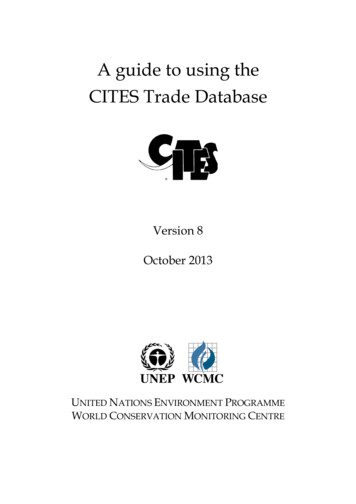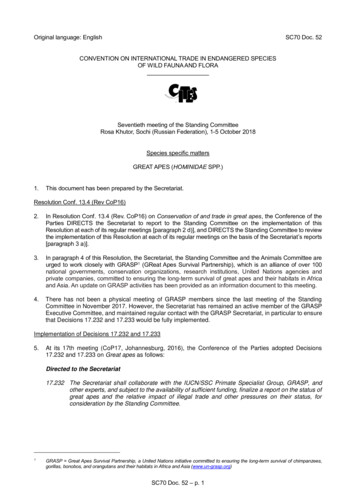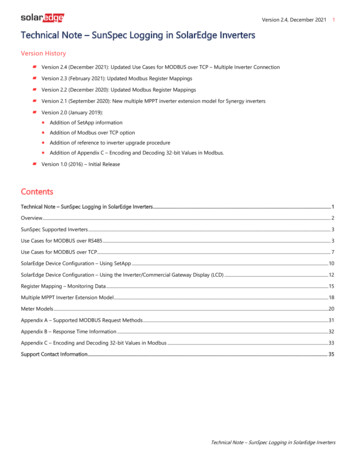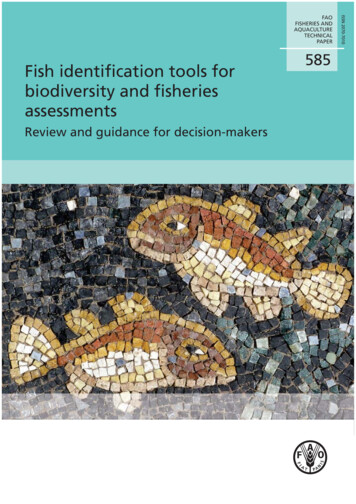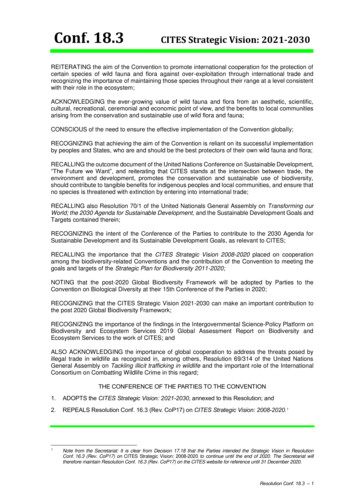
Transcription
Conf. 18.3CITES Strategic Vision: 2021-2030REITERATING the aim of the Convention to promote international cooperation for the protection ofcertain species of wild fauna and flora against over-exploitation through international trade andrecognizing the importance of maintaining those species throughout their range at a level consistentwith their role in the ecosystem;ACKNOWLEDGING the ever-growing value of wild fauna and flora from an aesthetic, scientific,cultural, recreational, ceremonial and economic point of view, and the benefits to local communitiesarising from the conservation and sustainable use of wild flora and fauna;CONSCIOUS of the need to ensure the effective implementation of the Convention globally;RECOGNIZING that achieving the aim of the Convention is reliant on its successful implementationby peoples and States, who are and should be the best protectors of their own wild fauna and flora;RECALLING the outcome document of the United Nations Conference on Sustainable Development,“The Future we Want”, and reiterating that CITES stands at the intersection between trade, theenvironment and development, promotes the conservation and sustainable use of biodiversity,should contribute to tangible benefits for indigenous peoples and local communities, and ensure thatno species is threatened with extinction by entering into international trade;RECALLING also Resolution 70/1 of the United Nationals General Assembly on Transforming ourWorld; the 2030 Agenda for Sustainable Development, and the Sustainable Development Goals andTargets contained therein;RECOGNIZING the intent of the Conference of the Parties to contribute to the 2030 Agenda forSustainable Development and its Sustainable Development Goals, as relevant to CITES;RECALLING the importance that the CITES Strategic Vision 2008-2020 placed on cooperationamong the biodiversity-related Conventions and the contribution of the Convention to meeting thegoals and targets of the Strategic Plan for Biodiversity 2011-2020;NOTING that the post-2020 Global Biodiversity Framework will be adopted by Parties to theConvention on Biological Diversity at their 15th Conference of the Parties in 2020;RECOGNIZING that the CITES Strategic Vision 2021-2030 can make an important contribution tothe post 2020 Global Biodiversity Framework;RECOGNIZING the importance of the findings in the Intergovernmental Science-Policy Platform onBiodiversity and Ecosystem Services 2019 Global Assessment Report on Biodiversity andEcosystem Services to the work of CITES; andALSO ACKNOWLEDGING the importance of global cooperation to address the threats posed byillegal trade in wildlife as recognized in, among others, Resolution 69/314 of the United NationsGeneral Assembly on Tackling illicit trafficking in wildlife and the important role of the InternationalConsortium on Combatting Wildlife Crime in this regard;THE CONFERENCE OF THE PARTIES TO THE CONVENTION1.ADOPTS the CITES Strategic Vision: 2021-2030, annexed to this Resolution; and2.REPEALS Resolution Conf. 16.3 (Rev. CoP17) on CITES Strategic Vision: 2008-2020.11Note from the Secretariat: It is clear from Decision 17.18 that the Parties intended the Strategic Vision in ResolutionConf. 16.3 (Rev. CoP17) on CITES Strategic Vision: 2008-2020 to continue until the end of 2020. The Secretariat willtherefore maintain Resolution Conf. 16.3 (Rev. CoP17) on the CITES website for reference until 31 December 2020.Resolution Conf. 18.3 – 1
Resolution Conf. 18.3 – 2
AnnexCITES Strategic Vision: 2021-2030IntroductionThe Convention on International Trade in Endangered Species of Wild Fauna and Flora (CITES) wasconcluded on 3 March 1973 and entered into force on 1 July 1975. CITES provides a global frameworkfor the legal and sustainable international trade in CITES-listed species. Today, CITES regulates tradein more than 36 000 species of wild animals and plants. CITES is widely regarded as one of the mostimportant international conservation instruments. Since 1975, the Conference of the Parties hasadapted this framework to changing circumstances and, through the adoption of Resolutions andDecisions, has demonstrated an ability to construct practical solutions to increasingly complex wildlifetrade and conservation challenges.The Conference of the Parties adopted its first strategic plan, the Strategic Vision through 2005, andan Action Plan at its 11th meeting (Gigiri, 2000). These were subsequently extended until the end of2007 at the 13th meeting of the Conference of the Parties (Bangkok, 2004).Initially, at its 14th meeting (The Hague, 2007), and with amendments agreed at its 16th (Bangkok,2013) and 17th (Johannesburg, 2016) meetings, the Conference of the Parties agreed a new StrategicVision for CITES for the period 2008-2020. The agreed amendments describe the contribution ofCITES’ activities to the achievement of the Strategic Plan for Biodiversity 2011-2020 and the relevantAichi Biodiversity Targets adopted by the Parties to the Convention on Biological Diversity, as well asto the achievement of the 2030 Agenda for Sustainable Development, and its Goals and targetsrelevant to CITES.With this new Strategic Vision, the Conference of the Parties to CITES outlines the Convention’sdirection for the 2021-2030 timeframe in fulfilment of its mandate. It is additionally recognized thatParties’ efforts to implement the Convention may also provide benefit to, and draw strength from, effortsbeing undertaken in other fora, and in this sense highlights the linkages between CITES and, inter alia,the processes and actions listed below:–the 2030 Agenda for Sustainable Development and its Sustainable Development Goals andtargets relevant to CITES, including those for terrestrial and marine wildlife;–the Strategic Plan for Biodiversity 2011-2020 and the post-2020 Biodiversity Framework beingdeveloped by Parties to the Convention on Biological Diversity;–the findings of the Intergovernmental Science-Policy Platform on Biodiversity and EcosystemServices 2019 Global Assessment Report on Biodiversity and Ecosystem Services; and–relevant resolutions of the United Nations General Assembly.The CITES Strategic Vision provides a framework for the future development of the CITES Resolutionsand Decisions and provides guidance on goals and objectives to be achieved. The Conference of theParties, through its Resolutions and Decisions, will determine actions to be taken by Parties, theCommittees or the Secretariat, as appropriate. The Strategic Vision also serves the Parties as a toolfor the prioritization of activities, and decisions on how best to fund them, in light of the need for theefficient and transparent use of resources.Vision StatementBy 2030, all international trade in wild fauna and flora is legal and sustainable, consistent with the longterm conservation of species, and thereby contributing to halting biodiversity loss, to ensuring itssustainable use, and to achieving the 2030 Agenda for Sustainable Development.ValuesParties to the Convention on International Trade in Endangered Species of Wild Fauna and Flora actin the best interest of the conservation of species, working to ensure their use is legal and sustainable,and aim to adopt measures proportionate to the anticipated risks to the species under consideration.In doing so, Parties have a shared commitment to fairness, impartiality, geographic and genderbalance, and to transparency.Resolution Conf. 18.3 – 3
PurposeThe twofold purpose of the Strategic Vision is:–as a priority, to improve the working of the Convention, so that international trade1 in wild faunaand flora is conducted legally at sustainable levels and supports the conservation of listed species;and–to ensure that CITES policy developments are mutually supportive of international environmentalpriorities and take into account new international initiatives, consistent with the terms of theConvention.Strategic GoalsIn order to achieve this purpose, five broad goals, of equal priority, have been identified as the keycomponents of the Strategic Vision:–Goal 1: Trade in CITES-listed species is conducted in full compliance with the Convention in orderto achieve their conservation and sustainable use;–Goal 2: Parties’ decisions are supported by the best available science and information;–Goal 3: Parties (individually and collectively) have the tools, resources and capacity to effectivelyimplement and enforce the Convention, contributing to the conservation, sustainable use and thereduction of illegal trade in CITES-listed wildlife species;–Goal 4: CITES policy development also contributes to and learns from international efforts toachieve sustainable development; and–Goal 5: Delivery of the CITES Strategic Vision is improved through collaboration.The goals aim at consolidating the existing strengths of CITES, ensuring the implementation of CITESand the achievement of its overarching aim as a priority, and further improving the relationship withcomplementary international efforts to achieve conservation and sustainable development, includingwith other relevant multilateral environmental agreements and related conventions, agreements andassociations.Goal 1 recognizes that only through ensuring compliance with CITES provisions will the aim of theConvention be achieved. This goal speaks to the performance of the Convention and how effectively itis resulting in the conservation and sustainable use of CITES-listed wild fauna and flora. It recognizesthat the effectiveness of the Convention at achieving its Vision depends upon its full implementation byall Parties. Full implementation includes commitment by each Party to the Convention and its principles.Equally important is the commitment of each Party to embody the international co-operation essentialfor the success of the Convention. Actions to achieve the intent of this goal might include developinginnovative tools for the identification and traceability of species in trade, the making of non-detrimentfindings, determining legal acquisition and for the sharing of trade information. It requires Parties todevelop provisions for trade that are proportionate and that can be implemented without unduecomplexity.In Goal 2, CITES Parties recognize the need to generate and have access to the best available scienceand information for supporting their trade risk assessments, listing proposals, permitting andenforcement decisions. Among others, information to support the making of non-detriment findings,determining legal acquisition and evaluating the care of live specimens might be found in the scientificliterature, population surveys, provenance records or professional literature and standards. Informationmight equally be held by national and international experts, including the relevant knowledge ofindigenous peoples and local communities. Further, in cases of uncertainty, either as to the status of aspecies, or the impact of trade, Parties commit to act in the best interest of the conservation of thespecies and aim to adopt measures proportionate to the anticipated risks to the species underconsideration.Goal 3 recognizes the necessity of appropriately supporting Parties to effectively implement theConvention. It is the CITES Parties that are responsible for ensuring enforcement and consistentapplication of the Convention’s obligations, and thus ultimately responsible for how effectively theConvention achieves its Vision. Practically, in addition to appropriate resources allocation to each Partyinternally, full implementation of CITES also demands the provision of timely capacity building and of1It should be noted that all references to 'trade' in the Strategic Vision refer to trade as defined in Article I of the Convention.Resolution Conf. 18.3 – 4
adequate financial resources. Underlying this goal is the recognition that effective enforcement is keyto combatting the threat illegal and unsustainable trade poses to wild flora and fauna. Parties recognizethe important role of CITES in global efforts to combat poaching and trafficking of species (including byincreasing the capacity of indigenous peoples and local communities to pursue sustainable livelihoodopportunities), to address both demand and supply of illegal wildlife products, and to tackle organizedcrime and poor governance, including corruption.Goal 4 explicitly recognizes the important contribution of CITES to the 2030 Agenda for SustainableDevelopment, which seeks to achieve sustainable development through balancing the economic, socialand environmental dimensions. It is a widely accepted and broad-scope international process, and itcontains several goals and targets that are directly or indirectly dependent on effective implementationof CITES, including supporting legal, sustainable wildlife trade, and tackling both illegal andunsustainable wildlife trade. CITES Parties understand and aim to communicate the importantcontribution the effective implementation of the Convention has in achieving the global SustainableDevelopment Goals. CITES Parties equally recognize the need to draw lessons from the global debateon sustainable development, in recognition that CITES stands at the intersection between trade, theenvironment and development.Finally, Goal 5 aims to use existing or new partnerships or alliances to help achieve its Strategic Vision.This could include work within existing partnerships, such as other conventions, internationalagreements and organizations, governments, non-governmental or intergovernmental organizations orothers, as well as partnerships at the national or regional level. It also reflects work to develop newpartnerships or alliances, as relevant and in order to advance the aim of the Convention, andmainstream CITES implementation with relevant sectors and stakeholders. The aim of suchcollaborations is mutually supportive, where CITES Parties can also help advance other internationalgoals or targets by simultaneously advancing the achievement of CITES goals.Within the framework provided by each of these goals, this Strategic Vision identifies a number ofobjectives to be achieved.CITES Strategic ObjectivesTo ensure that international wildlife trade does not threaten the survival of wild species of floraand fauna:GOAL 1TRADE IN CITES-LISTED SPECIES IS CONDUCTED IN FULL COMPLIANCEWITH THE CONVENTION IN ORDER TO ACHIEVE THEIR CONSERVATION ANDSUSTAINABLE USEObjective 1.1Parties comply with their obligations under the Convention through the adoption andimplementation of appropriate legislation, policies, and procedures.Objective 1.2Parties have established CITES Management and Scientific Authorities andenforcement focal points that effectively carry out the duties required of them underthe Convention and relevant Resolutions.Objective 1.3Implementation of the Convention at the national level is consistent with Resolutionsand Decisions adopted by the Conference of the Parties.Objective 1.4The Appendices correctly reflect the conservation status and needs of species.Objective 1.5Parties improve the conservation status of CITES-listed specimens, put in placenational conservation actions, support their sustainable use and promote cooperationin managing shared wildlife resources.GOAL 2PARTIES’ DECISIONS ARE SUPPORTED BY THE BEST AVAILABLE SCIENCEAND INFORMATIONObjective 2.1Parties’ non-detriment findings are based on best available scientific information andtheir determination of legal acquisition is based on the best available technical andlegal information.Objective 2.2Parties cooperate in sharing information and tools relevant to the implementation ofCITES.Objective 2.3Parties have sufficient information to enforce the Convention.Resolution Conf. 18.3 – 5
Objective 2.4Parties have sufficient information to make listing decisions that are reflective ofspecies conservation needs.Objective 2.5Information gaps and needs for key species are identified and addressed.GOAL 3PARTIES (INDIVIDUALLY AND COLLECTIVELY) HAVE THE TOOLS,RESOURCES AND CAPACITY TO EFFECTIVELY IMPLEMENT AND ENFORCETHE CONVENTION, CONTRIBUTING TO CONSERVATION, SUSTAINABLE USEAND THE REDUCTION OF ILLEGAL TRADE IN CITES-LISTED WILDLIFESPECIESObjective 3.1Parties have in place administrative procedures that are transparent, practical,coherent and user-friendly, and reduce unnecessary administrative burdens.Objective 3.2Parties and the Secretariat develop, adopt and implement adequate capacity-buildingprogrammes.Objective 3.3Sufficient resources are available at the national and international levels to supportnecessary capacity-building programmes and ensure compliance with and fullimplementation and enforcement of the Convention.Objective 3.4Parties recognize illegal trade in wildlife as serious crime and have adequate systemsin place to detect and deter it.Objective 3.5Parties work collaboratively across range, transit and destination states, to addressentire illegal trade chains, including through strategies to reduce both the supply of anddemand for illegal products, in order for trade to be legal and sustainable.Objective 3.6Parties take measures to prohibit, prevent, detect and sanction corruption.Objective 3.7Investments in building capacity of CITES are prioritized, coordinated, and theirsuccess monitored to ensure stepwise improvement through time.Objective 3.8Parties take full advantage of emerging technological developments to improve theeffective implementation and enforcement of the Convention.GOAL 4CITES POLICY DEVELOPMENT ALSO CONTRIBUTES TO AND LEARNS FROMINTERNATIONAL EFFORTS TO ACHIEVE SUSTAINABLE DEVELOPMENTObjective 4.1Parties support sustainable wildlife trade policies, especially those that increase thecapacity of Indigenous peoples and local communities to pursue livelihoods.Objective 4.2The importance of achieving CITES’ aim as a contribution to achieving the relevantSustainable Development Goals, as well as the post-2020 global biodiversityframework, is recognized.Objective 4.3Awareness of the role, purpose and achievements of CITES is increased globally.Objective 4.4CITES Parties are informed of international actions for sustainable development thatmay have a bearing on achieving the goal of CITES.GOAL 5DELIVERY OF THE CITES STRATEGIC VISION IS IMPROVED THROUGHCOLLABORATIONObjective 5.1Parties and the Secretariat support and enhance existing cooperative partnerships inorder to achieve their identified objectives.Objective 5.2Parties encourage the formation of new, innovative and mutually sustainable alliancesbetween CITES and relevant international partners, where appropriate to advanceCITES’ objective and mainstream conservation and of sustainable use of biodiversity.Objective 5.3Cooperation between CITES and international financial mechanisms and other relatedinstitutions is enhanced in order to support activities that contribute to CITESimplementation and enforcement.Resolution Conf. 18.3 – 6
1. ADOPTS the CITES Strategic Vision: 2021-2030, annexed to this Resolution; and 2. REPEALS Resolution Conf. 16.3 (Rev. CoP17) on CITES Strategic Vision: 2008-2020. 1 1 Note from the Secretariat: It is clear from Decision 17.18 that the Parties intended the Strategic Vision in Resolution
